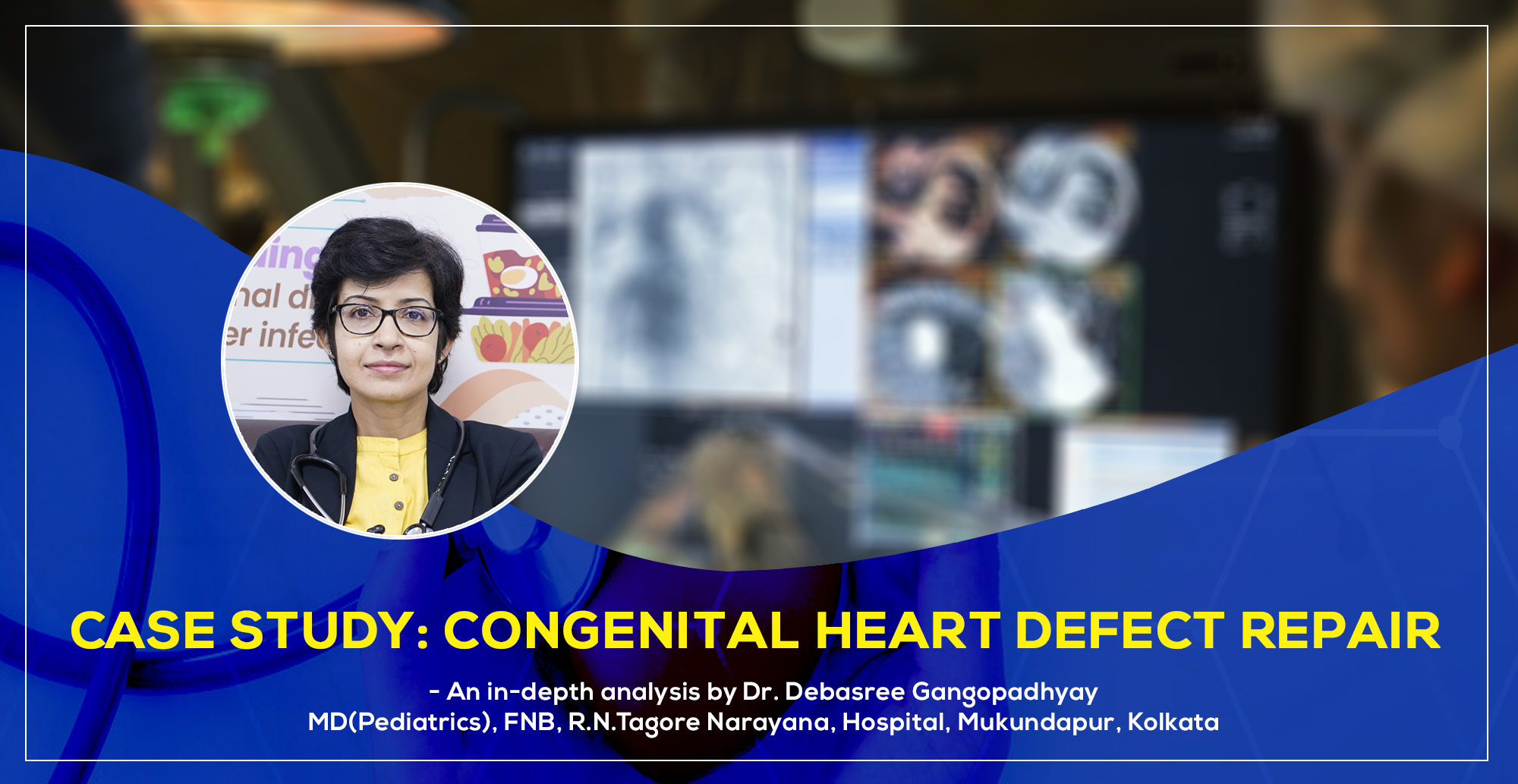Subtotal $0.00
Congenital Heart Defect Repair – A Detailed Case Study
Introduction to Congenital Heart Defects
What Are Congenital Heart Defects?
Congenital heart defects (CHDs) are structural abnormalities in the heart. These defects range from minor complications that may require minimal treatment to severe conditions requiring immediate medical attention.
Common Types of CHD
Some common types of CHD include:
- Atrial Septal Defect (ASD): A hole in the wall between the heart’s two upper chambers.
- Ventricular Septal Defect (VSD): A hole in the wall between the heart’s two lower chambers.
- Tetralogy of Fallot: A combination of four heart defects that affect blood flow through the heart and lungs.
- Patent Ductus Arteriosus (PDA): A condition where a blood vessel called the ductus arteriosus does not close after birth as it should.
Prevalence and Impact on Newborns
Congenital Heart Defects are among the most common birth defects globally that affect the heart’s structure and function of the child. According to the report, CHD is affecting approximately 1 in 100 live births. They can lead to developmental delays, and if untreated, they will have life-threatening complications.
Understanding Tetralogy of Fallot (TOF)
Defining Tetralogy of Fallot
Tetralogy of Fallot is a complex congenital heart defect involving anatomical abnormalities—ventricular septal defect, pulmonary stenosis, right ventricular hypertrophy, and an overriding aorta.
Common Symptoms of TOF in Infants
Symptoms include cyanosis (bluish tint to the skin and mucosa), rapid breathing, poor feeding, poor weight gain, and episodes of fainting or breathlessness.
Risk Factors and Genetic Links
Genetic factors play a significant role in the development of CHD. While the exact cause remains unknown, genetic disorders like Down syndrome, Di George syndrome increase the risk of TOF.
Diagnosing TOF Through Fetal Echocardiography
Importance of Early Diagnosis
Early detection and intervention of fetal heart problems is one of the most important parts of prenatal care. Early detection of fetal heart problems ensures timely planning for postnatal care and intervention, significantly improving outcomes. Proper parental care helps to reduce the risk of congenital heart disease.
How Fetal Echocardiography Works
This non-invasive imaging technique uses sound waves that visualize the structures of the fetus’s heart and assess its structure and function.
Key Indicators of TOF in Fetal Echo
A fetal echo can show all the components of TOF, confirming the presence of the condition. Color Doppler imaging highlights these abnormalities clearly. Important indicators of TOF include abnormalities such as a large ventricular septal defect, a mal positioned aorta, and smaller looking pulmonary artery.
This case study highlights the management of Tetralogy of Fallot in a newborn boy, prioritizing the diagnostic process, treatment plan, surgical procedural details, and follow-up outcomes. This case study explores the procedure and its impact, with a focus on the role of interventional congenital heart disease doctors in Kolkata.
Case Study: Management of Tetralogy of Fallot in a Newborn
Patient Background and Initial Assessment
The case involves a newborn boy diagnosed with TOF through routine fetal echocardiography during the 24th week of pregnancy. The mother had no significant medical history, ensuring focus on the cardiac defect.
Diagnostic Process and Confirmation
To confirm the diagnosis, the newborn underwent echocardiography testing after birth, which showed significant cyanosis and restricted blood flow.
Planning the Surgical Intervention
A multidisciplinary team of pediatric cardiologists and surgeons prepared a detailed plan for corrective surgery, prioritizing oxygenation to reduce complications.
Surgical Intervention in TOF
- Timeline for Surgery
In order to maintain urgency and physical preparedness, the surgical correction was planned for the newborn’s first three months. - Key Surgical Procedures
The procedure involved repairing the ventricular septal defect and ensuring proper blood flow. - Post-Surgery Recovery Phase
Monitoring in critical care, controlling oxygen levels, and progressively implementing feeding schedules were all part of the recovery process.
Long-Term Follow-Up and Developmental Outcomes
- Monitoring Cardiac Health
Regular check-ups, echocardiograms, and ECG ensured optimal cardiac function. - Supporting Development and Growth
Nutritional support, physical therapy, and developmental assessments played vital roles in the child’s overall well-being. - Lifestyle and Activity Adjustments
To avoid cardiac strain, the child could engage in moderate activities and be advised to follow a consistent bedtime to get adequate sleep for good heart health.
Challenges in Managing TOF Cases
- Addressing Post-Surgical Complications
Arrhythmias, valve dysfunction, and infection risks required constant attention. - Emotional and Psychological Impact on Families
Counseling and support groups helped families cope with the emotional strain of managing a CHD diagnosis. - Importance of a Multidisciplinary Approach
Collaboration among pediatric cardiologists, surgeons, nutritionists, and occupational therapists ensured comprehensive care.
Conclusion
In conclusion, Kolkata stands out as a leading hub for congenital heart disease treatment, offering world-class care for children with CHD, especially the management of Tetralogy of Fallot in a newborn. The expertise of the pediatric cardiologist in Kolkata and the advanced facilities available in Kolkata played a vital role in ensuring the best possible outcomes. Early diagnosis, advanced surgical techniques and a dedicated follow-up plan can significantly improve the quality of life for children with TOF. Collaboration between healthcare professionals and families is essential for managing this complex congenital heart defect.
FAQs on congenital heart defects
- What causes congenital heart defects?
The exact causes of CHD can vary, but it has some common reasons. Congenital heart defects are often caused by genetic mutations, chromosomal abnormalities, certain infections or environmental factors during pregnancy. - Can fetal echocardiography detect all congenital heart issues?
It is highly effective for identifying major structural abnormalities, including TOF. - How successful is TOF repair surgery?
TOF repair surgery has a high success rate, with most children leading normal, active lives post-repair. - Are there any long-term complications after TOF surgery?
Most of children recover well, but some may have valve problems or arrhythmias that require for further care or monitoring. - What role does a pediatric cardiologist play in managing TOF?
Pediatric cardiologists diagnose, guide treatment plans, and monitor long-term outcomes, ensuring holistic care for children with TOF.

Dr. Debasree Gangopadhyay is a highly respected pediatric cardiologist based in Kolkata, India, specializing in the diagnosis and treatment of heart conditions in children. With a compassionate approach and a commitment to excellence, Dr. Gangopadhyay has made significant contributions to the field of pediatric cardiology. Her expertise includes managing congenital heart defects, arrhythmias, and other cardiovascular conditions in young patients. Dr. Gangopadhyay is dedicated to providing personalized care and staying updated with the latest advancements in pediatric cardiology. She is passionate about educating families on heart health and actively participates in research and community outreach programs.




Comments are closed